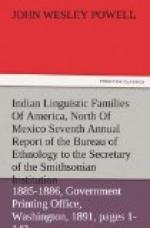Ayapai (Tule River). Chainimaini (lower King’s River). Chukaimina (Squaw Valley). Ch[-u]k’chansi (San Joaquin River above Millerton). [’C]hunut (Kaweah River at the lake). Cocon[-u]n’ (Merced River). Ititcha (King’s River). Kassovo (Day Creek). Kau-i-a (Kaweah River; foothills). Kiawetni (Tule River at Porterville). Mayayu (Tule River, south fork). Notoanaiti (on the lake). Ochingita (Tule River). Pitkachi (extinct; San Joaquin River below Millerton). Pohallin Tinleh (near Kern lake). Sawakhtu (Tule River, south fork). Tachi (Kingston). Telumni (Kaweah River below Visalia). Tinlinneh (Fort Tejon). Tisechu (upper King’s River). Wichikik (King’s River). Wikchumni (Kaweah River; foothills). Wiksachi (upper Kaweah Valley). Yukol (Kaweah River plains).
Population.—There are 145 of the Indians of this family now attached to the Mission Agency, California.
MOQUELUMNAN FAMILY.
> Tcho-ko-yem, Gibbs in Schoolcraft, Ind.
Tribes, III, 421, 1853
(mentioned as a band and dialect).
> Moquelumne, Latham in Trans. Philolog. Soc. Lond., 81, 1856 (includes Hale’s Talatui, Tuolumne from Schoolcraft, Mumaltachi, Mullateco, Apangasi, Lapappu, Siyante or Typoxi, Hawhaw’s band of Aplaches, San Rafael vocabulary, Tshokoyem vocabulary, Cocouyem and Yonkiousme Paternosters, Olamentke of Kostromitonov, Paternosters for Mission de Santa Clara and the Vallee de los Tulares of Mofras, Paternoster of the Langue Guiloco de la Mission de San Francisco). Latham, Opuscula, 347, 1860. Latham, El. Comp. Phil., 414, 1862 (same as above).
= Meewoc, Powers in Overland Monthly, 322, April, 1873 (general account of family with allusions to language). Gatschet in Mag. Am. Hist., 159, 1877 (gives habitat and bands of family). Gatschet in Beach, Ind. Misc., 433, 1877.
= Mi-wok, Powers in Cont. N.A. Eth,. III, 346, 1877 (nearly as above).
< Mutsun, Powell in Cont. N.A. Eth., III, 535, 1877 (vocabs. of Mi’-wok, Tuolumne, Costano, Tcho-ko-yem, M[-u]ts[-u]n, Santa Clara, Santa Cruz, Chum-te’-ya, Kaweya, San Raphael Mission, Talatui, Olamentke). Gatschet in Mag. Am. Hist., 157, 1877 (gives habitat and members of family). Gatschet, in Beach, Ind. Misc., 430, 1877.
X Runsiens, Keane, App. Stanford’s Comp. (Cent, and So. Am.), 476, 1878 (includes Olhones, Eslenes, Santa Cruz, San Miguel, Lopillamillos, Mipacmacs, Kulanapos, Yolos, Suisunes, Talluches, Chowclas, Waches, Talches, Poowells).
Derivation: From the river and hill of same name in Calaveras County, California; according to Powers the Meewoc name for the river is Wakalumitoh.
The Talatui mentioned by Hale[68] as on the Kassima (Cosunmes) River belong to the above family. Though this author clearly distinguished the language from any others with which he was acquainted, he nowhere expressed the opinion that it is entitled to family rank or gave it a family name. Talatui is mentioned as a tribe from which he obtained an incomplete vocabulary.




